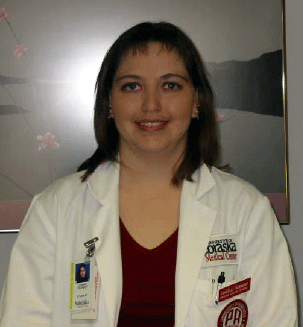 The shape of the Native American drum represents the circle of life and the act of drumming is connected to the heartbeat. It is just such spiritual linkage that drives JoniRai Schmidt’s desire to complete an advanced medical program and use her health science skills to enhance the circle of Native American life.
The shape of the Native American drum represents the circle of life and the act of drumming is connected to the heartbeat. It is just such spiritual linkage that drives JoniRai Schmidt’s desire to complete an advanced medical program and use her health science skills to enhance the circle of Native American life.
“There are few Native American health-care professionals,” said Schmidt, a member of the Iowa tribe. “It’s very rewarding to me to be able to help other Native Americans not only medically, but also as a health teacher and as a mentor.”
Schmidt, who graduates Friday (Dec. 19) from UNMC’s physcian assistant program, joins a national movement by Native Americans to take charge of the health of their own people. The need for Schmidt and more Native American health professionals is beyond question. California, for example, has the largest Native American population in the United States, but while there are 93,000 physicians in California, only 65 are Native American.
The American Indian and Alaska Native population is the smallest self-identified, racial-ethnic group in the United States, numbering about 2 million people. They are widely dispersed across the nation, belonging to more than 547 tribes and speaking more than 200 distinct languages. As a population, American Indians and Alaska Natives generally are younger, have less education and tend to be poorer than other populations in the United States. Because native people generally earn less than the average American and tend to live in remote, rural locations, some may have limited access to clinical preventive services, health education and prevention efforts. All these factors combine to place native people at a very high risk for chronic diseases.
Native Americans have traditionally cherished good health and longevity. Harmony with nature is important to an individual’s health and well-being and occurs simultaneously on physical, mental and spiritual levels. Traditional health is a holistic approach that involves treating the body, mind and spirit of the individual in addition to their symptoms and physical manifestations.
Native American health professionals have a better understanding of the unique communication styles of different tribal groups. For example, clients at one of the clinics may speak more generally, downplaying medical problems. What is described as a “bellyache” may, in fact, be something much more serious.
The desire to work closer with Native American patients and spend more time in the clinic with each patient is part of the reason Schmidt chose physician assistant medicine.
Schmidt was born in Gallup, N.M., grew up in the small town of Fort Lupton, Colo., and enrolled in the Iowa tribe in high school. It was during high school that Schmidt decided to become a physician assistant for several reasons, including a shorter training time than medical school — 28 months after undergraduate college, instead of four years.
“Physician assistants can spend a lot more time per patient and really get to know them and offer more health education,” she said. “The demands on a physician assistant’s time outside the office are not as heavy as the demands on a physician, so my family life will be less disrupted. There also is a shortage of physician assistants across the nation and I will have many job opportunities after I graduate.”
Physician assistants are health-care professionals licensed to practice medicine with physician supervision. Common services provided by a physician assistant include taking medical histories and performing physical examinations; ordering and interpreting lab tests; assisting during surgery; and counseling patients. Upon graduation, physician assistants take a national certification examination developed by the National Commission on Certification of Physician Assistants in conjunction with the National Board of Medical Examiners. To maintain their national certification, physician assistants must log 100 hours of continuing medical education every two years and sit for the recertification exam every six years. Graduation from an accredited physician assistant program and passage of the national certifying exam is required for state licensure.
To become one of the few Native American physician assistants in the United States, Schmidt enrolled in the pre-physician assistant program at Chadron (Neb.) State College. After graduating, she was admitted to the physician assistant program in UNMC’s School of Allied Health Professions. In the spring of 2003, UNMC and Fort Lewis College (Colo.) began a formal affiliation program that includes bringing Native American students to UNMC for summer research internships, faculty exchanges and recruiting more Native Americans students for UNMC’s health science programs.
Schmidt’s education included several clinical learning rotations on the Rosebud and Winnebago reservations in Nebraska.
“I especially enjoyed and was enlightened by my rotation working in obstetrics,” Schmidt said. “I participated in a number of child births. It’s amazing that even though all births are essentially the same, each one is actually different and wonderful.”
Schmidt’s learning experiences strengthened her resolve to serve Native Americans after she graduates, either in a community with a large number of Native Americans or by working for the Indian Health Service. The path to becoming a physician assistant has been hard, but she is glad she took the road less traveled.
“I have one thing to say to other Native Americans — go for it,” Schmidt said. “Don’t feel that any health profession is out of your reach.”